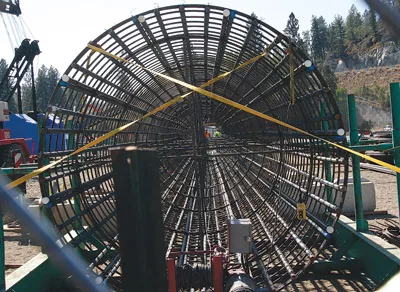
Home » Roads chief hears pitch for corridor
Roads chief hears pitch for corridor
Top U.S. highway official meets with Spokane group in Washington, D.C., office

October 1, 2009
A delegation of Spokane-area business leaders met Sept. 8 in Washington, D.C., with Federal Highway Administration chief Victor Mendez to make a case for a $35 million grant to complete construction of the southbound lanes of the North Spokane Corridor from Farwell Road to Francis Avenue.
Greater Spokane Incorporated President and CEO Rich Hadley says business leaders here hope for a favorable decision in January on the grant request and also will be working then to encourage federal lawmakers to put $300 million into federal highway authorization legislation to construct an interim four-lane, divided section of the corridor from Francis to the Spokane River.
"If the perception is we're getting to Francis and no further, that's not true. There is progress," Hadley says.
The Washington Legislature provided $28 million in its last session for the Washington state Department of Transportation to buy right of way between Francis and the Spokane River for the corridor, Hadley says. DOT already has begun buying right of way along Interstate 90, the corridor's southern end, from a separate $152 million allocation of funds.
The northbound leg of the freeway between Francis and Farwell Road was opened Aug. 22, although it carries traffic two ways for now because the southbound leg has yet to be completed. Work has begun on a four-lane section of the corridor between Wandermere and Farwell in a $321 million effort that is to be completed in 2011.
In the Sept. 8 meeting, Mendez "was engaged, listening, nodding, taking notes; he asked about five questions" during the 45-minute appointment, says Hadley. He says the meeting was set up through a new member of the K&L Gates LLP law firm who is a friend of Ray LaHood, the U.S. secretary of Transportation. K&L Gates is Greater Spokane Incorporated's lobbyist in Washington, D.C.
Washington DOT has submitted applications for discretionary TIGER grants under the American Recovery and Reinvestment Act for three high-priority projects, including the North Spokane Corridor stretch, Hadley says. One of the other applications is for a $300 million grant for a portion of a corridor for the planned state Route 520 Bridge replacement in King County.
The other application seeks $147 million for a state Route 500 interchange project related to the replacement of Interstate 5 bridges over the Columbia River between Vancouver, Wash., and Portland.
Each state will get no more than $300 million in TIGER grants, however, so the three Washington projects are competitive with one another, Hadley says. Still, he says he believes the North Spokane Corridor stretch from Farwell to Francis has a shot at being funded because its construction would result in a completed part of the corridor that drivers could use. That isn't the case for the other two projects, and the alignment hasn't been selected and environmental work hasn't been completed for the project related to the I-5 bridges, Hadley says.
Most of the grading work has been completed for the southbound leg of the corridor between Farwell and Francis, and Hadley says, "That's why it's a stimulus project. It's shovel ready. It's all graded; it's design prepared."
He says work could start on the project "within 45 days of the grant's confirmation," which is how long it takes for DOT to bid a project and award a contract. Hadley says the project would create 325 jobs.
"If we assume we get the TIGER grant, the whole route from Freya to Wandermere would be open in 2011, probably in late summer," Hadley says. He says the decisions on TIGER grants are to be made in early January, so construction could start in late March or April if the grant were awarded then.
The corridor is part of a federally designated freight-mobility route to improve the flow of goods between Canada and the U.S., and its completion would improve traffic safety and conserve fuel by getting big trucks off of relatively slow-moving Division and Hamilton, Hadley says.
"There are 225,000 'movements' of vehicles a day" on Division and Hamilton, and 18 stoplights slow traffic on Division between I-90 and U.S. 395, Hadley says. He adds that completion of the new corridor would benefit Hillyard by spurring economic development.
"The point we made is, 'If you look at the criteria,' and part of the criteria is: Is the unemployment rate in the area affected at least 1 percent higher than the national level, and is per capita income 80 percent or less than the national level," the Hillyard area qualifies, Hadley says.
Hadley says that Mendez commented, "The way you've explained this, you meet the criteria well," but also noted "there's going to be a lot of competition."
Mendez said that once the applications are in, he couldn't talk with the Spokane business leaders about the selection process, Hadley says.
The Spokane delegation was put together quickly when it was learned about 10 days before the meeting that Mendez would be available, Hadley says.
In addition to Hadley, the business delegation, which also met with members of the staffs of U.S. Sens. Patty Murray and Maria Cantwell and U.S. Rep. Cathy McMorris Rodgers, included Keith Metcalf, regional administrator of Washington DOT; Tim Welsh, president of Garco Construction Inc., who is a member of the Good Roads Association here; Glenn Miles, transportation manager of the Spokane Regional Transportation Council; Wayne Brokaw, executive director of Inland Northwest Associated General Contractors; Spokane County Commissioner Todd Mielke; and Betsy Cowles, chairwoman of both Cowles Co. here and Greater Spokane Incorporated.
Latest News
Related Articles


_web.webp?t=1764835652)
